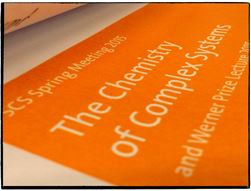This year’s Spring Meeting of the Swiss Chemical Society (SCS) was held at the University of Basel, Switzerland, on April 24. The meeting included five plenary talks, the presentation of the Werner Prize, and the General Assembly of the SCS. It was organized by Professor Thomas R. Ward and Professor Marcal Mayor from the University of Basel.
The SCS represents approx. 2700 individual and institutional members and has members in more than 50 countries.
Plenary Talks
Professor Itamar Willner, University of Jerusalem, Israel, gave a talk about supramolecular nucleic acid nanostructures. Togehter with his group, Willner has synthesized a five-ring DNA catenane that exists in four different configurations and demonstrates the cyclic reconfiguration of the system across these four states by the use of nucleic acids. Among these states is one that corresponds to the symbol of the Olympic Games, olympiadane (see picture).
Willner attached nanoobjects to the catenanes, which act as a mechanical scaffold to reconfigure the nanoobjects. These systems may find application as devices for molecular logic operations and add new dimensions to the area of DNA nanotechnology.
‘Unorthodox Reactions at Work’ was the title of the presentation by Professor Stefan Matile, University of Geneva, Switzerland, who was introduced as doing very creative work which is a result in part of his love of the arts. Matile’s work is inspired by highly sophisticated supramolecular architectures in Nature. Research topics included the transport of ions or molecules across lipid bilayer membranes, sensors, photosystems, and how to integrate interactions into functional supramolecular systems. Matile created, for example, mechanosensitive push–pull probes, called fluorescent flippers, which show fluorescence lifetime needed for practical use in biology.
Professor Roeland Nolte, University of Nijmegen, The Netherlands, talked about controlling molecular complexity by designing bio-inspired catalysts and materials. One of his studies deals with constructing a molecular Turing machine. Here, a polymer chain is encoded via allosteric information transfer between macrocyclic complexes, such as a dimeric complex consisting of two zinc porphyrin macrocycles bridged by a 1,4-diazabicyclo[2.2.2]octane (DABCO) ligand.
The next talk was very unique in the way it was presented: Professor David Leigh, University of Manchester, UK, accompanied his lecture on making tiny machines with magic tricks.
Leigh has developed strategies for the preparation of artificial molecular machines that can pick up and assemble reactive groups in sequence by traveling along a track. Leigh exemplified the methodology through a machine that adds four amino acid building blocks from a strand in sequence, featuring up to 20-membered ring native chemical ligation transition states.
Reprogramming the genetic code was the topic of the talk by Professor Jason Chin, University of Cambridge, UK. A challenge associated with genetic code expansion approaches is the site-specific incorporation of unnatural amino acids into proteins in mammalian cells. It will allow the synthesis of modified recombinant proteins and the introduction of new chemical functionalities into proteins to precisely control and image protein function in vivo. Chin has developed nanoscale molecular devices and systems that can perform novel mechanical tasks or catalyze novel chemical reactions. He has, for example, established a strategy for site-specific, live-cell, fluorescent labeling of intracellular proteins at high density for super-resolution imaging of ultrastructural features within cells.
Werner Prize 2015
The Werner Prize was awarded to Professor Gilles Gasser, University of Zurich, Switzerland, for his “outstanding contributions in the field of medicinal inorganic chemistry and of inorganic chemical biology”. The prize comprises CHF 10,000 and a bronze medal and is awarded annually to a promising young Swiss scientist or scientist working in Switzerland for outstanding independent chemical research. At the time of the award, the candidate should not be a tenured professor or someone in a higher position in industry and should be younger than 40.
In his award lecture, Professor Gasser discussed new techniques to fight cancer. Photodynamic Therapy (PDT) is an alternative to chemotherapy with less side-effects. Light of an appropriate wavelength range creates controllable cytotoxicity by turning a light-activatable chemical, the photosensitizer (PS), into a reactive molecular species.
A paramagnetic copper(II) porphyrin is the first PS to display excellent phototoxicity. The cytotoxic action of a substitutionally inert cytotoxic Ru(II) complex (pictured) was successfully unleashed in living cells upon light illumination (350 nm). This is the first substitutionally inert cytotoxic metal complex to be used as a light-triggered prodrug candidate.

Upcoming SCS Meetings
The next meeting of the SCS is the PolyColl 2015, the annual meeting of the Division of Polymers, Colloids and Interfaces. It will take place at Adolphe Merkle Institute, University of Fribourg, Switzerland, on Friday, July 3, 2015.
The Fall Meeting 2015 will take place at EPFL Lausanne, Switzerland, on Friday, September 4, 2015. The deadline for abstracts is May 12, 2015.
The 3rd Swiss Chemical Society – Syngenta Symposium 2015 will take place at Syngenta research campus, Stein, Switzerland, on Thursday, October 15, 2015. The focus will be on cutting-edge research in chirality and its role in life science, from synthesis and beyond for chemical innovation.
Attendance to these events is free for members of the SCS and the GDCh (Gesellschaft Deutscher Chemiker/German Chemical Society).
Also of interest
- Interview: Serving all Kinds of Chemical Scientists,
ChemViews Mag. 06 April 2015.
DOI: 10.1002/chemv.201500021
David Spichiger, Executive Director of the Swiss Chemical Society (SCS) on their strategic pillars, secrets for success, and challenges for the future - Interview: E. Peter Kündig: Chemistry in Switzerland,
ChemViews Mag. 07 January 2014.
DOI: 10.1002/chemv.201300124
The President of the Swiss Chemical Society talks about their program of reform and the fascination of discovery





.JPG)


